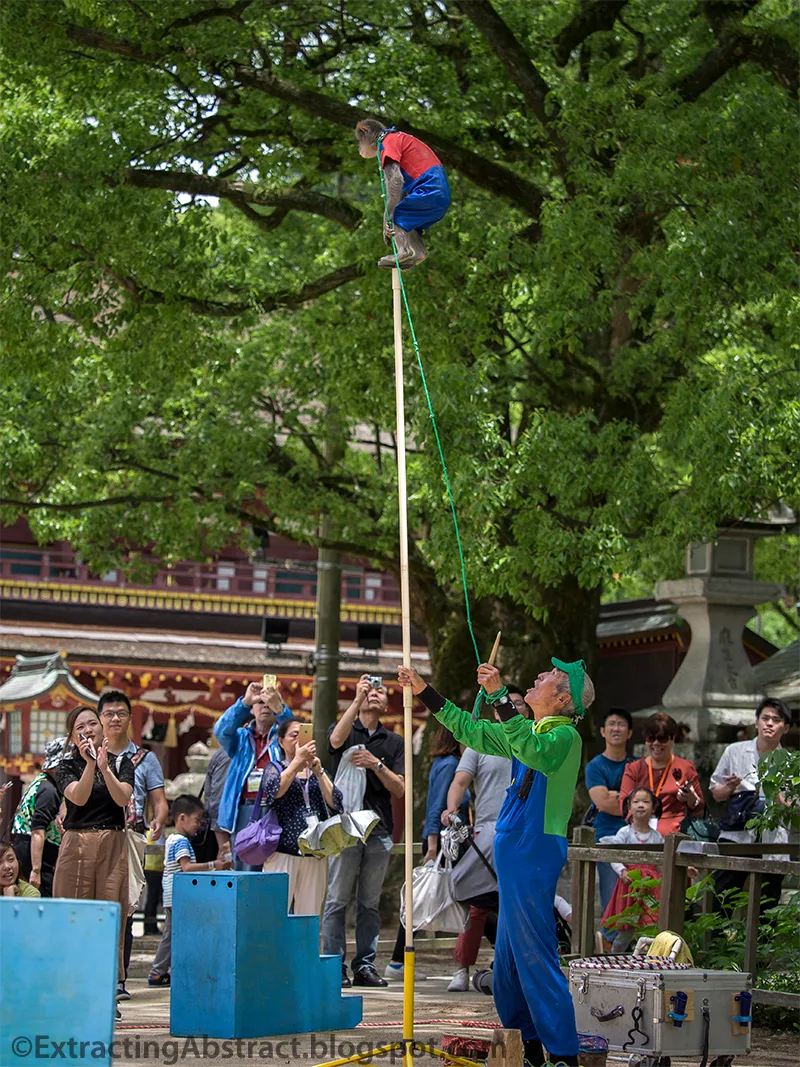Dazaifu Tenmangu (太宰府天満宮) is a shinto shrine located in Dazaifu of current Fukuoka Prefecture. From the 8th to the 12th centuries Dazaifu served as a local government dealing with foreign affairs (trading and military headquarter) and ruling several provinces in northern part of Kyushu.
Dazaifu Tenmangu launched its history as a mausoleum of Michizane Sugawara (菅原 道真 845 –903 A.D.), a scholar, poet, and politician of the Heian Period. Although several candidates are listed as Michizane's birthplace, he is said to be born in current Sugawara town in Nara city (well, town is named after his clan).
 |
| Statue of Michizane Sugawara |
In pre-modern time of Japan, the position of career was assigned according to the hereditary title of the family. Politicians and Bureaucrats started watching him with envy and malice as his position ascended. He was even encouraged by his opponent, Kiyotsura Miyoshi (三善清行), to retire from politics and enjoy the life but he refused to do so.
In 901, through the political maneuvering of his rival, Tokihira Fujiwara (藤原時平), Michizane was demoted from his aristocratic rank of junior second to a minor local post at Dazaifu that is far from the Kyoto Capital. Two year later from the dispatch (903 AD) he passed away there with great grief and despair, people who knew him thought so...
 |
| Map of Dazaifu - Tenmangu is located at north-east (鬼門) of Dazaifu. |
Today 11 statues of cow are scattered in shrine's precinct.
How many of them could I happen to find???
 |
| Cow/bull with red scarf |
 |
| Tip of right horn missing??? |
 |
| Relaxing under shadow |
 |
| My favorite |
 |
| Calf with white (stray) cat |
I found only 8 unfortunately during relatively short stay surrounded by countless numbers of foreigners mostly Chinese visitors. I heard more Chinese conversation than that of Japanese!!!!
Plum called Tobi Ume (飛梅) in Japanese is the sacred tree of Tenmangu. Three stocks of Tobi Ume trees grown in front of Main Hall were transferred from Enoki sha where Michizane passed away, meaning they are 1100 years old and still bloom every February!
 |
| Plum trees in front of Main Hall |
 |
| Inside of Main Hall |
 |
| Giraffe as an imaginary creature |
 |
| Statue of Lion??? |
Today he is well-known as a deity of studying but this was not the case from the beginning. Originally he was revered as Tenman-dai zizai Tenjin (天満大自在天神) because, after Michizane's death (903 AD), several coincidences took place in Kyoto. These include calamities such as a death of Michizane's rival, Tokihira Fujiwara in 909, Seiryo-den Palace (清涼殿) struck by lightning (清涼殿落雷事件) in 930 that resulted in couple of bureaucrat's death as well as Emperor Daigo (醍醐天皇), drought to starvation, plague breakout, and so on. Whenever the disasters and calamities struck in Kyoto capital, people freaked out and feared that Michizane ('s evil spirit) caused them. To calm his spirit down, Kitano Tenmangu (北野天満宮) was built in 947. That's how Michizane was enshrined as Temjin deity.
Back in olden days people believed that the river is the border between the life and death. The bridge is, literally, the path to connect two distinct world. Politicians and bureaucrats who persecuted Michizane to death with despair didn't want his spirit to come back to their world and punish them as a vengeance.
 |
| Image is from official site with modifications, indicating the position and the number of bridges. |
 |
| Bridge #1 called Taiko (= drum) bridge (太鼓橋) representing "past" |








No comments:
Post a Comment
Your comments are always welcome! It's NOT a bad idea to follow this blog, if you are not a follower already:)
日本語でのコメント大歓迎です。